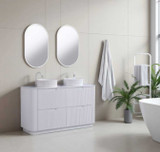Nostalgic Charm: Exploring 1950s Family Homes in Australia
Step back in time and discover the captivating world of 1950s family homes in Australia. This post aims to provide an insightful glimpse into the architecture, design, and materials used during this era, reflecting a unique period of post-war growth and suburban development. Let's embark on a journey to explore the cherished abodes that held the dreams and memories of Australian families during the 1950s.
1. Architectural Style and Design
The 1950s marked a period of significant change and transformation in Australian housing. Influenced by international architectural trends, the post-war years saw a departure from the traditional architectural styles and the emergence of modern design principles. Modernism, with its emphasis on simplicity, functionality, and clean lines, became the prevailing style for new homes.
One popular architectural style during this era was the "California Bungalow." These single-story, low-pitched roof homes blended elements of American and British design. They featured large windows, open floor plans, and porches, evoking a sense of spaciousness and connection with the outdoors.

2. Exterior Features
Exteriors of 1950s family homes often exhibited a sense of uniformity and neatness, reflecting the growing trend of suburbanization. Typically, these homes were made of brick, weatherboard, or fibro cement sheets. Brick homes, with their durability and timeless appeal, were particularly favoured.


The facades of 1950s homes were characterized by clean lines and symmetrical designs. Horizontal elements such as wide eaves, horizontal weatherboards, and long windows were prevalent. Gable or hipped roofs were commonly seen, adorned with terracotta or concrete tiles. The front yards were often meticulously landscaped, showcasing manicured lawns, flower beds, and picket fences.
3. Interior Layout and Features
As with the exterior, simplicity and functionality were key features of 1950s interior design. The open floor plan concept gained popularity, promoting a seamless flow between living spaces. The living room served as the heart of the home, often featuring large windows to welcome ample natural light.

Kitchens of the 1950s were a hub of activity, designed for efficiency and convenience. Pastel colors like mint green, baby blue, and pale pink were popular choices for cabinetry, and linoleum or tiled floors were favored for their practicality. Appliances such as refrigerators, stoves, and dishwashers became more commonplace, heralding a new era of modern living.

Bedrooms were often modest in size, featuring built-in wardrobes and hardwood flooring. The bathroom typically included a bathtub, pedestal sink, and brightly colored tiles, reflecting the optimistic spirit of the time.
4. The Backyard and Outdoor Living
The Australian climate encouraged an emphasis on outdoor living during the 1950s. Backyards were considered an extension of the home, providing space for children to play and families to entertain. Gardens were well-tended, showcasing a mix of flower beds, fruit trees, and vegetable patches.
Outdoor entertainment areas featured barbecues, picnic tables, and space for relaxing. Hills hoists, the iconic rotary clotheslines, became a common sight in backyards, symbolizing the suburban lifestyle.

The 1950s was a transformative period for Australian family homes, characterized by modern design principles and a growing focus on suburban living. The architectural styles, materials used, and interior layouts reflected the desire for simplicity, functionality, and connection with nature. These homes, with their charming facades, open living spaces, and well-kept gardens, continue to hold a special place in the hearts of Australians, serving as a nostalgic reminder of a bygone era.
As we reflect on the past, we appreciate the enduring appeal and timeless elegance of 1950s family homes in Australia. They stand as a testament to the dreams, hopes, and aspirations of the families who lived within their walls, leaving an indelible mark on Australian architectural history.
Recent Posts
-
The Sink Warehouse Unveils the New Roma Floor-Standing Vanity Range
Perth, Australia – October 2025 — Following the success of last year’s Roma Fluted Wall-Hung Vanitie …30th Oct 2025 -
The Sink Warehouse Mega Reno Sale: Big Renovation Savings Before Christmas
The Sink Warehouse Mega Reno Sale: Big Renovation Savings Before Christmas Perth, Australia – Octobe …30th Oct 2025 -
Upgrade Your Space with the Perfect Fit Series – New from The Sink Warehous
Your kitchen is more than just a space—it’s the heart of your home. Whether you're renovating o …14th Apr 2025




